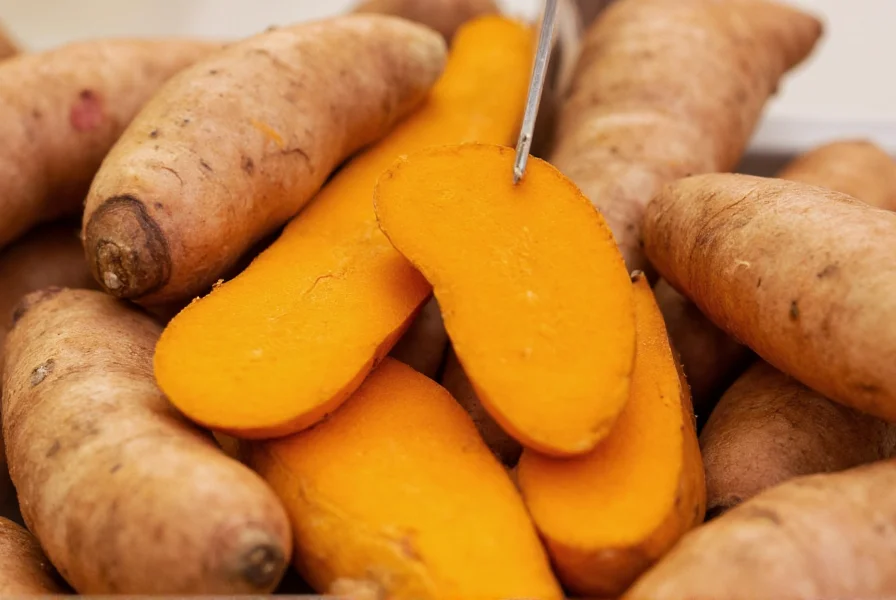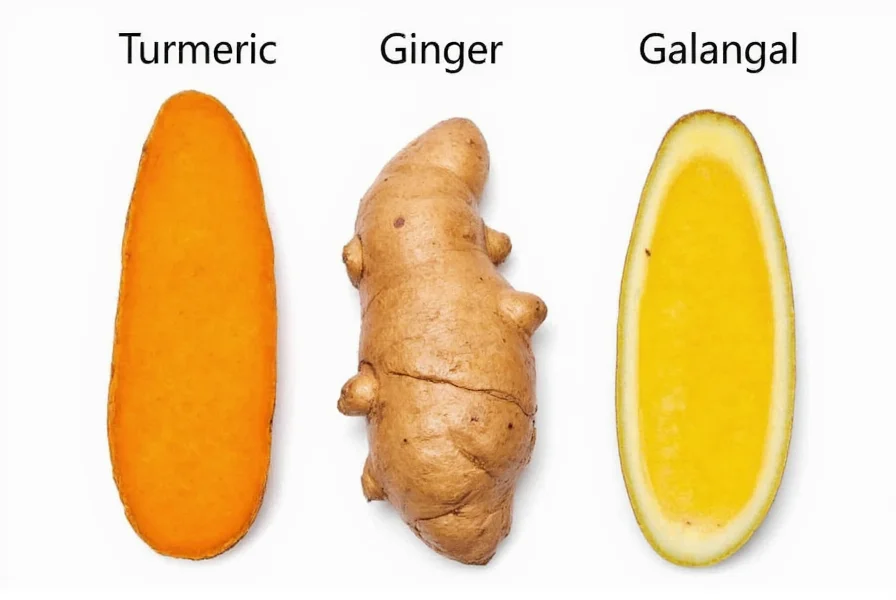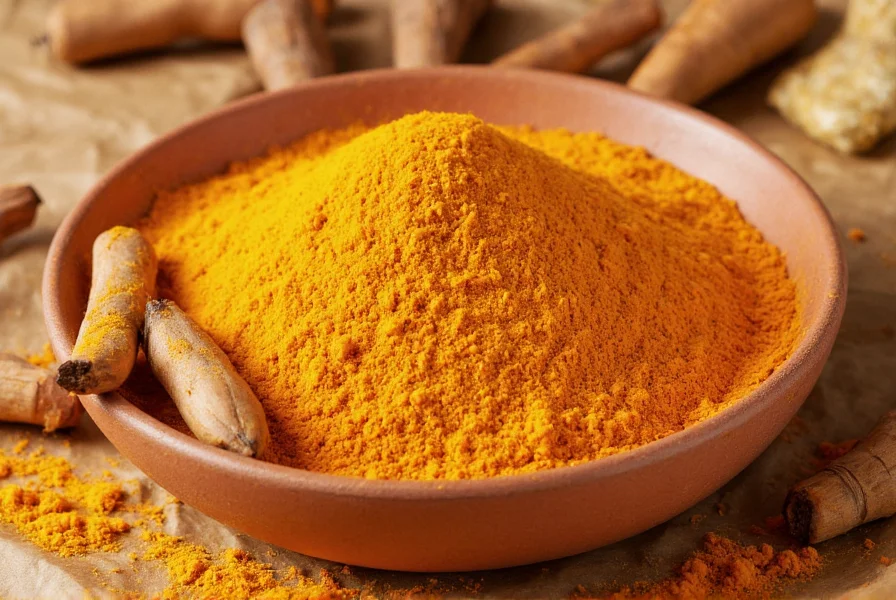When searching for turmeric picture references, understanding the visual characteristics of this popular spice in its various forms is essential for proper identification and usage. Turmeric (Curcuma longa), a member of the ginger family, has distinct visual features that differentiate it from similar-looking spices.
Visual Characteristics of Fresh Turmeric Root
Fresh turmeric root, often called turmeric rhizome, displays distinctive physical properties. The exterior features a rough, brown skin similar to ginger, but with a more cylindrical shape and fewer branching 'fingers.' When cut open, the interior reveals a brilliant orange-yellow color that immediately distinguishes it from pale yellow ginger. This vibrant hue comes from curcumin, the primary active compound responsible for turmeric's health benefits and staining properties.

Dried Turmeric Root Appearance
Dried turmeric root undergoes significant visual transformation during the dehydration process. The brown skin becomes more brittle and darker, while the interior color deepens to a richer orange. Properly dried turmeric maintains its characteristic shape but becomes harder and less pliable than fresh root. When comparing turmeric picture examples of fresh versus dried forms, note that dried turmeric often appears more wrinkled and less vibrant than its fresh counterpart, though the distinctive orange-yellow color remains evident when broken open.
Turmeric Powder Visual Identification
Turmeric powder represents the most commonly used form in cooking and supplements. High-quality turmeric powder displays a consistent, deep golden-yellow color with no visible specks or discoloration. The texture should be fine and uniform, similar to other spice powders like cinnamon or paprika. When evaluating turmeric powder picture examples, look for the intense yellow-orange hue that immediately stains fingers and surfaces upon contact—a key identifier of authentic turmeric versus adulterated products.
| Form | Color Characteristics | Texture | Distinctive Features |
|---|---|---|---|
| Fresh Root | Brown exterior, vibrant orange-yellow interior | Firm, moist, slightly fibrous | Strong earthy aroma, stains skin immediately |
| Dried Root | Dark brown exterior, deep orange interior | Hard, brittle, less pliable | Concentrated color, less moisture content |
| Powder | Rich golden-yellow to orange | Fine, uniform consistency | Strong staining properties, distinctive aroma |
Distinguishing Turmeric from Similar Spices
Many people confuse turmeric with ginger due to their similar root structure. When examining turmeric root picture comparisons, note these key differences: turmeric has a more uniform cylindrical shape with fewer branches, a brighter orange interior (versus ginger's pale yellow), and a distinct earthy, slightly bitter aroma. Galangal, another ginger relative, has a smoother skin and pinkish hue when cut open—features that help differentiate it from turmeric in visual comparisons.

Practical Applications of Visual Identification
Accurate visual identification of turmeric serves multiple practical purposes. In cooking, recognizing fresh turmeric helps determine ripeness and quality—plump, firm roots with smooth skin indicate freshness. For gardeners, understanding what does turmeric look like during growth stages helps monitor plant development. In commercial settings, visual inspection prevents substitution with inferior products. When purchasing turmeric powder, the intense yellow-orange color should be consistent throughout, with no dull patches that might indicate age or adulteration.
Avoiding Common Visual Misidentifications
Several common mistakes occur when visually identifying turmeric. Some vendors dye inferior products to mimic turmeric's vibrant color, creating fake turmeric picture examples that look authentic but lack quality. Real turmeric powder immediately stains fingers yellow-orange, while adulterated versions may show weaker coloring. Fresh turmeric should have a firm texture—soft or moldy spots indicate spoilage. When comparing turmeric vs ginger picture references, remember that while they share structural similarities, their interior colors and aromas differ significantly.
Conclusion: Key Visual Indicators
Understanding what turmeric looks like in its various forms provides valuable knowledge for culinary, medicinal, and gardening applications. The vibrant orange-yellow color across all forms—fresh root, dried root, and powder—serves as the most reliable visual identifier. When examining turmeric pictures for reference, focus on the intensity of the yellow-orange hue, texture characteristics, and distinctive staining properties that set authentic turmeric apart from look-alikes or adulterated products.
Frequently Asked Questions
What does fresh turmeric root look like compared to ginger?
Fresh turmeric root resembles ginger in shape but has a more cylindrical form with fewer branches. The key visual difference appears when cut open—turmeric reveals vibrant orange-yellow flesh while ginger shows pale yellow interior. Turmeric also has a darker brown skin and stronger staining properties than ginger.
How can I tell if turmeric powder is authentic from a picture?
Authentic turmeric powder displays a consistent, rich golden-yellow to orange color throughout. In high-quality pictures, you should see uniform texture without specks or discoloration. Genuine turmeric powder has strong staining properties, so images showing the powder on light surfaces often reveal slight yellow staining around the edges, which is a good authenticity indicator.
What color should proper turmeric be in pictures?
Proper turmeric should show a vibrant orange-yellow color in pictures. Fresh turmeric root has brown skin with bright orange-yellow interior when cut. Dried turmeric maintains this orange hue but appears deeper, while turmeric powder displays a rich golden-yellow to orange color. The intensity of this yellow-orange color directly correlates with curcumin content and quality.
Why does turmeric stain surfaces in pictures?
Turmeric contains curcumin, a natural pigment that gives it its distinctive yellow-orange color and strong staining properties. In authentic pictures, you'll often see turmeric staining cutting boards, fingers, or containers yellow-orange. This staining is a natural characteristic and indicates genuine turmeric—products that don't stain may be diluted or fake.
How does dried turmeric differ visually from fresh turmeric?
Dried turmeric appears darker and more brittle than fresh turmeric. The brown skin becomes more wrinkled and darker, while the interior orange color deepens. Fresh turmeric has higher moisture content, making it plumper and more flexible. In side-by-side pictures, dried turmeric shows less vibrant color than fresh but maintains the characteristic orange-yellow hue when broken open.











 浙公网安备
33010002000092号
浙公网安备
33010002000092号 浙B2-20120091-4
浙B2-20120091-4